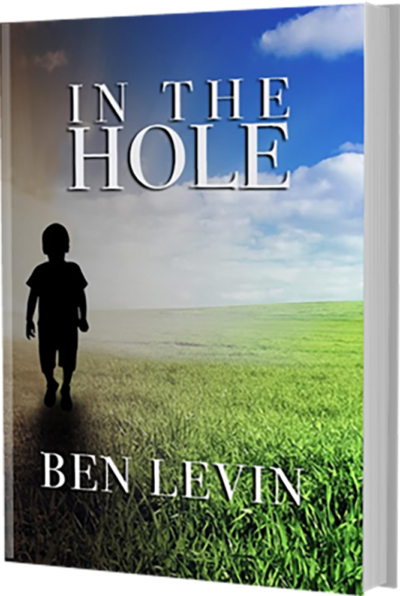Booktrib Reviews In the Hole!
benmbd2022-03-24T18:30:18+00:00March 21, 2022|
What inspired you to write this book? Do you ...
Midwest Book Review: Susan Bethany’s Bookshelf
benmbd2022-03-10T16:48:54+00:00September 21, 2021|
Susan Bethany's Bookshelf reviews 'In The Hole' as part of the Midwest Book Review web site.
Midwest Book Review: Children’s Bookwatch
benmbd2022-03-10T13:10:39+00:00September 21, 2021|
Children's Bookwatch reviews Ben Levin's 'In the Hole' as part of the Midwest Book Review web site.
TeenInk Magazine reviews Ben Levin’s ‘In The Hole’
benmbd2022-03-09T16:40:37+00:00July 19, 2021|
TeenInk Magazine reviews Ben Levin's "touching, comprehensive tale about the Kimball family’s struggles" in his new book 'In The Hole'
Readers’ Comments

Told from David’s point of view, the book recounts his experiences and emotions as his world is shattered. David’s parents sell off the family’s possessions, including David’s, triggering the beginning of his understanding of his privilege—and how an unexpected misfortune such as job loss can remove that privilege.
When the family is evicted and their belongings put out on the street, David’s horror and shame are believable. Mr. Levin does not sugar coat what follows next: David confronts life sleeping with his family in a small, borrowed car, relying on the kindness of a church for access to bathrooms, and a night sleeping unsheltered in the woods, before finding refuge in an extended stay, low cost “inn.”
David also experiences hunger, including its impact on his own ability to concentrate in school as well as on his younger sister’s health. He confronts the shame he feels at his poverty and the bullying of some of his peers, and to accept and appreciate the eventual support of his friends. He also experiences the impact of his situation on his own and his family’s mental health, including his father’s alcoholism, violence and depression, as well as his mother’s unexpected anger.
David has a hard time keeping up in school and sports while trying to cope with homelessness and hunger; his grades plummet and he is removed from his beloved basketball team. By skillfully including these and and other hard but realistic challenges, the book avoids sugar coating the experience of homelessness. By presenting them through David’s eyes, it evokes empathy and understanding.
The book also includes some unusually fortunate circumstances, often not available people who lose their homes. For example, David and his family have a network of economically comfortable friends who provide a safety net of sorts; they also have access to an “inn” that offers shelter, seemingly without conditions or time limits. Still, this also highlights the importance of this networks and resources, and does not detract from the significance of the book and its potential to raise awareness for young readers.
Well written and engaging, In the Hole offers a much needed perspective on an urgent social issue that is critical for young people understand. By painting a portrait of a likable, relatable boy who nonetheless loses his home, it counters many of the harmful myths about homelessness, how and why it happens, and whom it affects. By showing David’s ultimate exit from the crisis, as well as his later commitment to helping others, it also lays out a path for active engagement by other young people.
In the Hole by Ben Levin enlivens a triumphant crucible through the perspective of one charismatic and compassionate David Kimball. The homeless story is spun as a fresh take as we see our protagonist grow out of the hole in his most formative years as a child. Walking the marathon of homelessness in David’s worn-down basketball shoes truly teaches the reader the importance of unwavering trust in the face of adversity. You won’t want to put the book down, and when you finally do – you’ll want to make a difference for the less fortunate.
This book should be in the hands of all upper elementary school and middle school students. Ben tells the story bringing in humor, the boy’s love of sports and how he dealt with harsh realities of bullying and of how love and compassion can triumph over the worst of times. Bravo, Ben!
Although the story is fiction, the emotions felt by David, the main character, and his family are spot on. Ben Levin conveys the shame and embarrassment felt by many families experiencing homelessness. More importantly, he astutely describes the hope that families in this difficult situation derive from the kindness and support of good friends and the community at large.
Ben Levin is a young author with a descriptive writing style that is mature beyond his years. In The Hole follows the life of David and his family as they navigate the real world of poverty, homelessness, and addiction.
Coping with life’s difficulties, David tackles his problems head-on and thoughtfully. The character development of both David and the supporting characters weave an arc that is both realistic and believable.
Written in a positive tone, In The Hole helps the young reader navigate through life’s difficulties with resilience. As David encounters life’s setbacks, he tackles these problems with a grace and maturity that should be an example for young adult readers.
In The Hole checks all of the boxes: depth, emotion, character development, a deep inspirational thread, and an interesting storyline from beginning to end.
What a wonderful experience this book gives into the life of a student and his family life. As a school counselor, I don’t always know what a student is experiencing at home, and learning more about the whole student can help me help them in their academics and life while at school. Ben brings themes into the book that so many students struggle with on a regular basis and I can see pieces of some of the students I work with in different sections of the book. This is a great read for anyone working with students, to get a better perspective on the hardships they may be experiencing and offering grace and compassion for each student’s current life situation.
I thoroughly enjoyed Ben Levin’s In the Hole. Nine year old David Kimball’s world is turned upside down when his father loses his job and his family faces unparalleled financial hardship. Although homelessness is the main theme in the novel, the author also tackles bullying, addiction and serious illness. The reader witnesses David’s pain and growth in each page. Although, David faces difficult circumstances, you cannot help but feel uplifted and motivated to help others as you read.
I highly recommend this book to any middle school students. In the Hole is sure to evoke feelings of empathy along with a desire to make a difference in our world.
Ben Levin’s young characters evince an authentic voice that can only come from such a young writer.
Ben is a good writer because he is a good reader and has learned and observed how to set up relatable problems in a novel. The story is paced well; we learn with David, as events unfold, from the perspectives of both adults and children. For example, I was struck by the authenticity of David being called lazy when his fellow students did not understand the challenges he was facing.
We see in this novel that even in the most challenging of situations, children and parents do not lose their humanity. The Happy Meal scene reminded me of this.
More broadly speaking, I think the scenes in school emphasize how important school communities can provide a home for students even when their families are struggling to make their own home secure.
I recommend In the Hole to readers of all ages.
In The Hole by Ben Levin is an incredible story diving deep into the life of a young boy, David Kimball, who is faced with homelessness. Through his eyes, the reader is exposed to the harsh reality of not only homelessness, but some of the factors that come along with it such as; addiction, bullying and hunger. David realizes how often privilege is taken for granted and struggles with many overwhelming emotions as his world falls apart around him. Due to his hunger, David has trouble in school and finds it increasingly harder to keep up with his sports. His story opens the readers eyes to a critical, under-addressed social issue and the emotions that come along with it and David, being the lovable character he is, brings up pity, understanding and compassion from the reader.
This book is a great read for everyone but especially for anyone who is experiencing hardships such as David. Ben’s story provides a safe space to show people that they are not alone and there are so many people who want to and will help. This is a great book by a great author and everyone should take the time to read it and to help raise awareness about homelessness for young readers.





